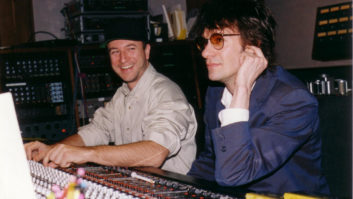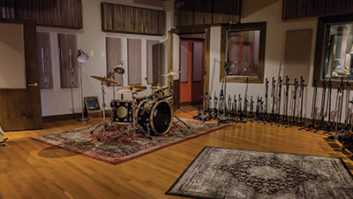Rules, as they say, are rules. During the recording sessions for Blues Traveler’s seventh release, Bridge, engineer Trina Shoemaker was the one making the rules. “There was a moratorium on guns in the control room. I didn’t want smoking in the control room,” Shoemaker states. “John [Popper] did both. He’s naughty. Most people will listen to me if I say, ‘No smoking in the control room.’ But John would come right up there and blow cigarette [smoke] in my face.” The next rule came after the band returned to the studio after an afternoon basketball game. “We had to have a ‘no stinky guy in the control room’ rule, too, which was for my benefit. That’s what happens when you have a girl around.”
Before the band — which recently added keyboardist Ben Wilson and bass player Tad Kinchla to the lineup of John Popper on vocals, harmonica and guitar, lead guitarist Chan Kinchla and drummer Brendan Hill — joined Shoemaker at The Plant in Sausalito, Calif., they spent three weeks in pre-production. It was a time to hone the songs, says producer Matt Wallace. “I’m a very strong proponent of pre-production, because I think that’s where records can be made or broken,” he explains. “That’s also where we worked on the grooves, arrangements and parts. The process of making a record, once you have your map, is relatively uncomplicated.”
During those pre-production sessions, Wallace started with a very relaxed, sitting-on-the-couch type of atmosphere. Hill was on a baby drum kit, and the rest of the band was playing through small amplifiers. “We had everything kind of toned down, which is really a nice way to do pre-production,” Wallace says. “That way, you can talk about the music and there’s minimal ear fatigue. Then, once you’re feeling confident that you’ve got it, it’s, ‘Okay, let’s strap on the big loud instruments and take it for a spin.’”
Because Blues Traveler is, first and foremost, a touring band (see accompanying article, “That Travelin’ Sound”), they brought their entire rig with them to The Plant. “When the gear showed up in San Francisco, I just panicked,” Shoemaker recalls. “I said, ‘I can’t do this, I should just go home. There are too many cases, not enough room.’ I asked John’s tech, ‘Okay, for John Popper’s harmonica, how many outputs do I need?’ I’m thinking like a mic and a DI or something. He said, ‘I think it’s nine.’ I need nine tracks to go to tape with? Nine whole tracks of Popper harmonica?” That was just the beginning, though, because there was also the Popper guitar rig, Chan Kinchla’s two amps, Wilson’s array of piano, Wurlitzer, Clavinet and B-3, not to mention the rhythm section and vocals.
It was important to have all the instruments available, Shoemaker says, because the goal was to capture as much as possible live in the studio. “Every song on the record, we attempted to have bass, drums and the whole milieu of keyboards be the take of those instruments,” she explains. “When we finally said it was a master, it was, because everyone was happy that the drums felt great; the bass was cool — it just needed a few punches; piano sounded amazing — just a few fixes; guitars are good, but we’re going to redo one whole track; and John’s harmonica is happening. For the most part, once we established a basic track it would already have bass, drums, keyboards, guitars, most likely a damn-good scratch vocal, and Brendan would put percussion on right away.”
SQUEEZING THE VOCAL
To capture Popper’s vocals, Shoemaker used a Neumann U67 for tracking and overdubs. She turned to the Neve mic pre’s in the console, as well as the combination of a Distressor, an 1176 and an LA-2A. “John sings loud,” she explains. “I squeeze vocals. I know a lot of people don’t; I just do. I just squeeze ’em to death. It sounds good and why not? We’re competing with rock ‘n’ roll elements, so you have to treat it like a rock ‘n’ roll element, and a voice needs to be treated like a kick drum, where all of his sounds need to be compressed into an area that will fit in the song, but always be present.”
Wallace was impressed during Popper’s vocal dates. “It was really interesting, because getting him up to the microphone can take a lot of effort sometimes,” he says. “He even admits that he’s one of the laziest guys, but when you get him to the microphone, he is outstanding. It’s like in three takes, wow! It’s such an interesting dichotomy to me, to find someone who’s so incredibly gifted and has such abilities, but you have to work so hard to get him to the point where he’s going to let loose and let the stuff out. Great phrasing, pitch, everything.”
As for the nine tracks of harmonica — distortion harp, clean harp, Leslie harp, effect harp and phase harp are among the Popper choices — Shoemaker had her hands full. “He would step on pedals, but he would send them through different processing units and ultimately different outputs,” she recalls. “So that’s why we had to have a whole section of the console dedicated to it. And John would say, ‘It doesn’t matter, because this harp track will be just a scratch track.’ I thought, ‘Baloney, you’re going to play really great, and then Matt Wallace is going to be looking at me like, ‘You got that, right?’ So I just made sure even though he said we’d never use any live harp tracks, we used all live harp tracks, almost exclusively.”
WHICH GUITAR?
Guitarist Chan Kinchla came into the studio with his Soldano tour rig, which was augmented by an assortment of Ampeg, Vox, Fender and Marshall amplifiers. He would run two concurrently, going through a box that simply read Amp A, Amp B or both. According to Shoemaker, one was a super-distorted channel and the other a clean channel. “I had two mics on each cabinet in its enclosure,” she says. “The mics were bused together through a compressor, then to tape. So, at any time Chandler had guitar one, guitar two and I would never know which one he was going to play, so they were both up at the console, both up in his headphones. And they were both always going to tape.
“I figure two mics are better than one, because you get two mics’ worth of sound and then you put it together with a compressor,” she adds. “Again, somebody would argue with that and say, ‘Technically, that’s not right.’ But it sounds real good. It comes up fat, and if one mic shits out on me, I can hear it and I can kill it, and I’ve still got a mic going to tape. I like to put tube mics on guitar amps, because they sound great. At the console, I didn’t always use both mics; I’d put up the 47 and think, ‘Hot damn, sounds great, done.’ But if it sounded a little bright, then I’d throw up a 421 to add bottom end. I don’t like to EQ guitar sounds, because I’m convinced that I can’t make it sound better with an EQ. I can in the mix, but if you’re recording it and it’s just not sounding good in there, the fact is that you have to go back out there while he plays, and it’s really loud and you’re going deaf, and you have to listen to what the amp sounds like.”
14 MICS, ONE KIT
Shoemaker approached Hill’s drum kit much like she did the rest of the band: Mike just about everything possible, add a bit of compression to the kick drum and don’t touch the EQ. In all, she says, they used 14 mics on the kit. “It was probably overkill at some point,” she admits with a laugh. The toms and snares got top and bottom mics, the kick drum got a close and far mic, the cymbals and room were miked, and she threw in “a crazy-sounding mic” for good measure. “I blend them into sets or into one mono kit if I feel like it,” she explains. “I like to have a lot of drum mics available at the console, because that way, if I have to change the drum sound, they can put in a new drum kit, I can slightly revise my mic blends or my choices and have a brand-new drum sound with very little effort and no moving around of mics.” Snare drums got 57s, there was a 451 on the hi-hat, 421s on the toms, a U47 in the room, and a D-112 inside the kick drum and a U47 on the outside.
Hill’s rhythm partner, Tad Kinchla, also brought in his live rig, which included “some complicated shit with some preamp box and a speaker cab and a sub cab,” Shoemaker says with a laugh. “That was cool, but I wasn’t familiar enough with it to right away want to trust it. So I asked him if he would mind if I had him run just a regular old Ampeg B-15, because I’m familiar with that. Then I gave him his live rig, which consisted of his DI out of his preamp and a combination of the cab and the sub cab blended together.” Typically, all three tracks were used. “Once again, it was overkill, but I didn’t want to say to him, ‘You know what? We’re going to do things my way and my way is a B-15, so forget your rig.’ He was comfortable with his rig, but just to humor me, ‘Do you mind if I run this little extra-warm lovely bass cabinet?’ His rig was cool, but it was too big for recording. On some songs, his sub cabinet mixed in with his bass cabinet was the perfect answer and the B-15 was turned down, but mostly all three went to tape.”
Adding Ben Wilson’s keyboards to the Blues Traveler sound was a new experience for the entire band, but it wasn’t a struggle for Shoemaker. She miked the heavily blanketed piano — which was in the same room as the drums — and miked the Leslie cabinets and Clavinet. “He had a whole pedal board for his Clav and his keyboards, so basically I had an amp and a DI sound for the Clav and the Wurlitzer. So, if it was going to be an amp sound, I was ready; if it was a DI sound, I was ready,” she says. “Again, EQ to taste when it was necessary, but mostly just staying out of his way. I just made sure that all of the keyboards that he could possibly reach were going to tape — if he stretched across the room and touched that crazy-looking Casio keyboard, it was on tape.”
EMOTION ON TAPE
Although The Plant sessions were recorded right to tape, the band used Pro Tools — for the first time — on a pair of songs, “Pretty Angry” and “You Reach Me.” The band had performed three versions of “Pretty Angry,” which is about the death of bassist and founding member Robert Sheehan. But none were hitting the emotional mark they were feeling. Hill, who brought in his own Pro Tools rig, put together two takes for the final version. “No one really thought we had the take, no one was 100 percent happy with it,” Hill recalls. “I worked on it overnight and brought back a rough CD the next day, and everyone said, ‘Wow, that’s what we wanted.’ It was something that was intimate at the beginning, and then the piano comes in and it’s very moving, and then the voice comes in and then the whole band comes in. Then the rest of the take, which is the one that we wanted, built up with a really nice emotional vibe to it.”
From Wallace’s seat, finding the right time to record that song was tough. “Pretty much all the songs were pretty easy birthing, except for ‘Pretty Angry,’” he says. “The day after the anniversary of Bob’s death — they had gone out on a Sunday and sprinkled his remaining ashes on San Francisco Bay — my instinct told me, ‘Okay, they’ve got this residual emotion in their bodies. Monday is going to be the day to attack “Pretty Angry.”’ I think my instincts were right, because I could tell they were all still digesting and trying to understand what happened the day before. We spent a good part of the day going after it, and toward the end of the day, once the emotional depth had settled into all our psyches, that’s when we really got a take.”
Certainly, the passing of Sheehan hung over the band during the recording process and, to be sure, the tours they had staged before the recording of Bridge. Hill admits it was emotional for the band to be working without him. “It was strange going into the studio or throughout the whole process from rehearsing to pre-production without having Bob there,” he says. “There wasn’t a shadow, but you felt like there was a presence there just kind of checking things out. He contributed a lot to the dynamic and feel of the band, but more than that he was one of our schoolmates and friends. I think it’s hard to carry on without bringing some of his energy with you, and I think we all have that in the back of our minds.”
Then again, Hill adds, the band feels a renewed sense of purpose. “The new energy of the new band is a little bit healthier, especially since John’s lost a lot of weight,” he says. “He’s got a lot more energy, full voice, doesn’t get tired so quickly, and I think that has a big impact as we move forward. Everyone’s excited about touring again and there’s no kind of health problems looming over our heads. There’s the sadness of Bob’s passing, but also the happiness of this rebirth.”
David John Farinella is a frequent contributor to Mix.




